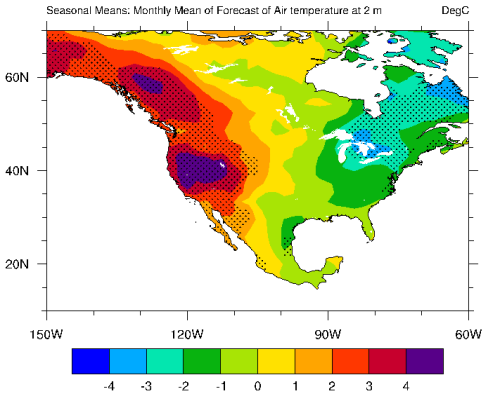Is Ensemble Average Suitable for Forecast of Climate Extreme?
Date:2017-03-15
Ensemble average forecast is the main method for climate forecast in the global main forecast centers, but its appropriateness for forecast of climate extremes is still questionable. Dr. XIE Jinbo from Institute of Atmospheric Physics has recently taken the US winter 2014-15 extreme event (DJF15) as an example to show the deficiency of ensemble average in capturing the major characteristic of the observation.
This research utilizes the AGCM with observational DJF15 sea surface temperature and sea ice concentration to form 100 ensemble simulations with different initial condition to examine its ability to forecast the DJF15 event. Ensemble average of the 100 ensembles has failed to capture the East cold pattern in DJF15 (Fig.1). A cluster analysis of the ensembles has shown a similar cluster with the observation, with its cluster number indicating a low probability of this event.

Figure 1. Mean surface temperature anomaly in DJF15 (oC); All anomalies are relative to the period of 1979-2012. The dots indicate regions where amplitude of the anomalies exceeds the standard deviation. Robinson projection from 0oN to 90oN. (Image by XIE Jinbo)
This research appeals to the use of methods such as cluster analysis in taking full advantage of the ensemble members to make probabilistic forecast of the future events, thus supplementing the original ensemble average, and cope with the increase of high impact extreme event under the climate change.
Reference:
Xie, J., and M. Zhang (2017), Role of internal atmospheric variability in the 2015 extreme winter climate over the North American continent, Geophys. Res. Lett., 44, doi:10.1002/2017GL072772. http://onlinelibrary.wiley.com/doi/10.1002/2017GL072772/full
Contact: XIE Jinbo, xiejinbo@mail.iap.ac.cn
